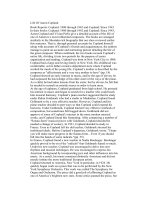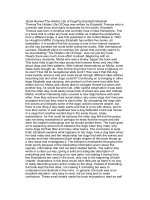life of leorando da vinci 1209
Bạn đang xem bản rút gọn của tài liệu. Xem và tải ngay bản đầy đủ của tài liệu tại đây (38.45 KB, 2 trang )
April 15, 1452 Ser Piero and Catarina (her first name is all that we know today) gave birth to
arguably the most important man in history, Leonardo da Vinci. Leonardo was born in a
farmhouse in Anchiano, which is 3 km away from Vinci. Leonardo's family had lived in this area
since the 13th century.
Ser Piero, Leonardo's father, was a 25-year-old lawyer when Leonardo was born. As the story
goes, Ser Piero did not marry Leonardo's mother (Catarina) because she was the daughter of a
farmer. This caused many lifelong legal and emotional problems for Leonardo. Ser Piero did
marry a woman shortly after Leonardo was born, her name in unknown. Leonardo had a total of
four stepmothers in all, but it's thought that Leonardo's near by uncle is the one who nurtured
Leonardo's powerful drive to learn.
Leonardo was christened at the Baptismal Church in Vinci. The parson Piero da Bartotomeo
christened Leonardo to the name Lionardo, and not Leonardo. Leonardo lived in Anchiano for
about 5 more years, until he moved to Vinci.
In 1457 Leonardo moved with his grandfather from Anchiano to Vinci. From this time forth
Leonardo was a member of his father's family. Ser Piero and his first wife did not have any
children; this may have been the reason for Leonardo's integration into his father's family.
Leonardo attended school in Vinci. Leonardo's teachers often became annoyed with his constant
questioning of what they had just taught, and his many doubts. While in school, Leonardo learned
to write, read, and calculate. He was also taught Latin and geometry. Leonardo believed that he
had not learned enough Latin in school, so he taught himself more of it. In 1466, after Leonardo
turned 16, he moved to Florence to begin his apprenticeship in the workshop of Verrocchio.
Leonardo began his apprenticeship under Andrea del Verrocchio in 1466. Verrocchio was at this
time the most gifted and magnificent artist in Florence. Verrocchio had much influence on the
young Leonardo, but Leonardo also had influence in Verrocchio. Verrocchio was so fascinated by
Leonardo's drawings, that he gave Leonardo a place in his workshop. While working with
Verrocchio, Leonardo got a chance to work with some of the other great artists of the time, such
as Botticelli, Perugino, and Lorenzo di Credi.
During the years 1466-1472, there were no known works of art from Leonardo. At this time
Leonardo taught himself how to paint in oils. One day when he painted an angel-Leonardo was
known to draw better angel faces than anyone-Verrocchio reportedly threw down his paint brushes
in jealous admiration and swore he would never paint again. In June 1472 Leonardo had begun
being listed in the red books of painters from Florence. With the membership in the painter's guild
of Florence, Leonardo's apprenticeship to Verrocchio ended. Still Leonardo always felt at home
with Verrocchio and in times of stress he would return to visit with him.
Leonardo's first dated work is a pen and ink drawing of the Arnovalley. He drew it on August 5,
1473. This picture shows the ingenious mind of Leonardo, because he drew the landscape in a way
that could have been real. No other artist had done this before.
On April 8, 1476 an anonymous person denounced Leonardo for having had a homosexual affair
with one of his models. This was a great heresy against the church, punishable by death. He was
acquitted of the charge but after this he was even more secretive than before.
In 1476 Leonardo and Verrocchio were commissioned to paint the Baptism of Christ. This is a
great picture to compare and contrast Leonardo's methods with Verrocchio's.
Leonardo was not just skilled as a painter. He was also a very good sculptor even though none of
his pieces of sculpture survived the vandalism through the years. More than a great artist, he was a
great thinker, the best of his time and possibly the best of all time. With the skills that Leonardo
possessed he could easily have become a city planner, architect, inventor, engineer, physician,
musician, anthropologist, botanist, or astronomer.
Leonardo was a very curious person. His most frequently used words in his notebooks were "I
question. His questions ranged from what it would be like to walk on water to would a fly make a
different sound if you put honey on its wings?
Leonardo learned about human anatomy the same way most artists learned about it at the time.
They did autopsies on cadavers. Leonardo had to keep his autopsies secret because they were
banned by the
Church. To make matters worse he was left handed, which in those days was perceived as a sign
of the devil. He was a vegetarian because he felt sorry for the animals that people ate. All of these
personal habits and characteristics and his secrecy made people begin to think that he was a dark
wizard, and his experiments were rumored to be a type of black magic. Leonardo's desire for
privacy was so much so that he wrote all of his notes backwards so that no one else could read
them.
He was a different type of man. He was strong, healthy and handsome with a carefully curled and
brushed beard. His rose colored robes were short, unlike the robes of most men. He was always
extremely clean in an age when most people weren't. He couldn't even stand to have paint on his
fingers. Most of the time he was calm, though he was known to blush when someone insulted him
like his arch-rival Michelangelo. Leonardo was a welcome addition to any party because of how
he was able to devise clever riddles that made people roll with laughter. He even like to play
pranks on people that would make them scream. Once he even unleashed what appeared to be a
dragon, but it was only his lizard. He was an excellent horseman, sang well, played the lyre well
and was capable of inventing his own instruments when needed. His favorite food was minestrone
soup. There were two things that would put Leonardo in high spirits. They were flying and his
design for a submarine.
Leonardo had no family of his own, but he adopted a peasant boy who lived with him for 26 years.
The boy was known as Salai, which means Devil, because he constantly stole from people. He
even stole from Leonardo. In 1515 Leonardo drew a self-portrait of himself.
King Francis I invited Leonardo to spend the last span of his life in Ambosie. In the autumn of
1516 Leonardo arrived in Ambosie carrying the Mona Lisa. Leonardo's final 3 years were the
most serene of his life. He came down with paralysis on the right side of his body in 1517 and his
health continually declined after this time. On April 23, 1519 Leonardo wrote his last will, and on
May 2, 1519 Leonardo
Di Vinci died. Vasari (a friend of Leonardo's) told the legend that King Francis I immediately
came to Ambosie when he heard that Leonardo was near death. The painting from Cesare Mussini
shows this last meeting, but it is only a legend, because King Francis was in St. Germain en Laye
on May 1, 1519.









